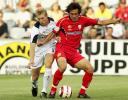As I have written previously, the Australian A-League introduced the marquee player system as a way of attracting quality players while preventing expensive bidding wars that risked placing clubs in financial danger before the season was even underway.
A well selected overseas marquee player offers more to a club and the League than just razzle and dazzle on the park. A true marquee player draws in the media, attracts attention of the wider public, brings more people through the turnstiles and lends football some credibility. For so long the slave of the ugly sisters of league, union and Australian Rules, a true marquee is the fairy godmother bringing the A-League to the Ball.
Season 1 — 2005/06
There were only two overseas marquee players in the inaugural A-League season in 2005/06. Despite the hype and excitement around the new competition, clubs were acutely aware of the pressure to remain financially prudent. Much was riding on the A League achieving what the NSL could not — a vibrant, successful and sustainable competition.
Dwight Yorke

Shengqing Qu

Season 2 — 2006/07
Despite the success of Yorke, it seemed that clubs were not prepared to splash around big dollars for an overseas player. Perhaps the internal turmoil at Sydney FC left clubs feeling gun shy and unwilling to take too many risks, and risks they were with neither marquee player leaving much of an impression on the League or indeed even their chosen clubs.
Shengqing Qu
Qu returned to China in the off-season but re-signed with Adelaide later in the season. He was plagued by ankle problems and spent large parts of the season on the injured list. Qu’s form dropped to such an extent and didn’t even feature in the top 30 goal scorers, a fatal situation for a marquee striker. His contract was not renewed at the end of the season.
Scot Gemmill

The above demonstrates that the A-League gained little from overseas marquee players in Season 2.
Season 3 — 2007/08
After the poor strike rate for overseas marquees in Season 2, there were some big name signings in 2007/08. With the League settling in as a worthy competitor for the attention of the sports loving public, clubs had a new-found confidence when it came to spending the big bucks.
Juninho

Mario Jardel

Success?
Looking at the results, it is apparent that the overseas marquee system has provided mixed results over the first 3 seasons of the League. From 5 overseas marquee players, only one, Dwight Yorke, could be considered an unqualified success. He scored goals, brought glamour to and sparked interest in the inaugural A-League season. While Shegqing Qu also scored goals in the first season, he was never going to be a “glamour” signing and spent large parts of his second season injured before returning to China.
Of the remaining players, I hadn’t even heard of Scot Gemmill until I started research for this article. Part of this ignorance is because the NZ Knights were an abysmal team that even no one in New Zealand wanted to watch play, but also because he did nothing all season. Mario Jardel was an example of the kind of marquee player that the A-League should be avoiding — an once-was trading on past glories while trying to be a once-again. Juninho promised so much but spent most of his season on the bench, unable to adjust to the physical nature of Australian football (which is strange when you consider how well he did in the EPL). However I can’t fault Sydney FC for trying. Juninho still has an excellent touch on the ball and inspired passing ability He was a gamble worth taking. If he had been able to keep injury free, he could well have eclipsed Yorke as the greatest marquee signing yet.
It is too early to write off the marquee system just yet. Next time I will look at the Australian marquee and how they have fared in comparison to their overseas colleagues.
Part 1: Introduction to the Marquee player system
Part 2: Has the overseas Marquee experiment worked?
Part 3: Coming home – the local Marquee players
Shane Perris is the resident geek of techwhimsy.com and journeyman wingback for Narrabundah FC.
Add Sportslens to your Google News Feed!